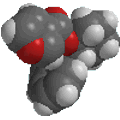| Chapter 1: Structure Determines Properties |
| Chapter 1: Structure Determines Properties |
Depending on the nature of the difference
between the structures, it
is possible to classify isomers into various sub-types. The following
tree
diagram should help you recognise the differences based on a simple YES
/ NO question. If you "click" on the named boxes there is a link
to a definition and an example.
 |
© Dr. Ian Hunt, Department of Chemistry, University of Calgary |  |